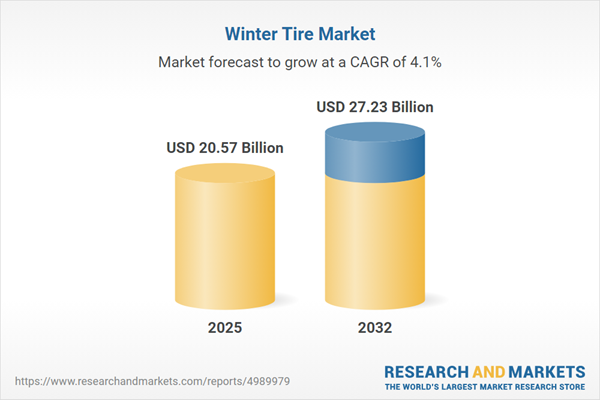Speak directly to the analyst to clarify any post sales queries you may have.
The global winter tire market is undergoing transformative changes as sustainability, digitalization, and regulatory alignment increasingly shape operational priorities for leading manufacturers and suppliers. Senior decision-makers face new challenges and opportunities as the sector evolves in response to shifting climate patterns and mobility trends.
Market Snapshot: Winter Tire Market Size and Growth
The winter tire market grew from USD 19.75 billion in 2024 to USD 20.57 billion in 2025, with projections indicating continued expansion to reach USD 27.23 billion by 2032—driven by a CAGR of 4.09%. Growth is fostered by a combination of regulatory adaptations, the rising influence of electric vehicles, and innovative business models targeting diverse regional demands. Increasing environmental mandates and evolving mobility behaviors are pushing companies to enhance their product portfolios and capitalize on new sales and distribution strategies to maintain competitive relevance globally.
Scope & Segmentation
This comprehensive winter tire market research provides senior executives with actionable insights across critical segmentation and regional layers, ensuring precision in strategic planning and risk assessment. The report breaks down the marketplace as follows:
- Type: Studded and studless tires, each designed for optimal grip and safety in distinct ice and snow conditions; these variants reflect ongoing advances in rubber compound technologies tailored to varying winter environments.
- Construction: Bias and radial formats, providing fleet managers and passenger operators with structural choices that balance durability with vehicle performance under demanding seasonal scenarios.
- Vehicle Type: Passenger cars, light commercial vehicles, SUVs, and light trucks—segments where optimal traction and handling directly impact operational efficiency and safety in winter months.
- Application: Both OEM fitment and the replacement market are addressed through an expanded network that includes independent workshops, online and offline retailers, and specialist distributors—meeting differing procurement cycles and lifecycle preferences.
- Distribution Channel: Traditional dealerships and specialty outlets remain vital, while digital marketplaces and manufacturer webstores increasingly cater to shifting purchasing behaviors and just-in-time supply demands.
- End User: Distinct insights are provided for fleet operators and end consumers, each with unique requirements for procurement, lifecycle management, and compliance.
- Region: Extensive analysis covers the Americas, Europe, Middle East & Africa, and Asia-Pacific, with targeted country-level intelligence to align product strategies and navigate evolving local regulations.
- Key Companies: The benchmarking section analyzes prominent players including Bridgestone, Michelin, Continental, Goodyear, Pirelli, Yokohama, Hankook, Nokian Tyres, Sumitomo, and Kumho Tire, focusing on product innovation, supply chain agility, and strategic adaptability.
Key Takeaways for Senior Decision-Makers
- Continuous development in rubber compounds and tread designs support rising industry safety standards, enabling premium manufacturers to address the increased frequency and unpredictability of severe winter conditions.
- Electrification trends in automotive platforms prompt targeted R&D investments, as winter tires for electric vehicles focus on optimizing rolling resistance and extending driving range without sacrificing road safety.
- Digital transformation is altering every touchpoint, from purchase decision to aftersales care. Tire sensor technologies and integrated online commerce are reshaping how organizations manage the entire tire lifecycle, driving efficiencies and transparency.
- Distinct legislative frameworks across North America and Europe require precise compliance strategies. Market entrants and established players must adapt OEM and aftermarket supply plans to regional certification and distribution standards.
- Rising sustainability expectations among regulators and corporate clients stimulate the adoption of bio-based elastomers and recycled materials, supporting environmentally aligned operations and longer-term brand credibility.
Tariff Impact: United States 2025 Policy Shift
Forthcoming U.S. tariffs are prompting winter tire manufacturers to diversify sourcing strategies and restructure supplier networks across Latin America and Southeast Asia. Adjustments in supply scheduling and expanded service offerings within distribution have emerged as key tactical responses to short-term cost pressures. Partnerships with logistics and procurement specialists are increasingly vital to maintaining supply chain continuity and product quality amid policy-driven disruptions.
Methodology & Data Sources
Analysis in this winter tire market report is based on primary interviews with OEM engineers, supply chain leaders, and regional distributors, supported by end-user survey data. Secondary information draws from established industry publications, updated regulatory documentation, and manufacturer disclosures. All insights are validated through triangulation and advanced analytical modeling.
Why This Report Matters
- Equips senior executives with evidence-based intelligence on technology evolution, regulatory trends, and digital transformation impacting the winter tire market.
- Clarifies the influence of regional complexities and supply chain risks on market entry, positioning, and strategic risk mitigation.
- Highlights practical trends in product innovation, customer decision-making, and competitor response, optimizing commercial investment strategies for sector growth.
Conclusion
Successful winter tire industry leaders will leverage up-to-date market intelligence to guide operational agility and regulatory alignment as global conditions shift. Integrating technology and supply chain insight is essential for sustained competitiveness.
Additional Product Information:
- Purchase of this report includes 1 year online access with quarterly updates.
- This report can be updated on request. Please contact our Customer Experience team using the Ask a Question widget on our website.
Table of Contents
3. Executive Summary
4. Market Overview
7. Cumulative Impact of Artificial Intelligence 2025
List of Figures
Companies Mentioned
The key companies profiled in this Winter Tire market report include:- Bridgestone Corporation
- Compagnie Générale des Établissements Michelin S.C.A.
- Continental Aktiengesellschaft
- The Goodyear Tire & Rubber Company
- Pirelli & C. S.p.A.
- Yokohama Rubber Co., Ltd.
- Hankook Tire & Technology Co., Ltd.
- Nokian Tyres plc
- Sumitomo Rubber Industries, Ltd.
- Kumho Tire Co., Inc.
Table Information
| Report Attribute | Details |
|---|---|
| No. of Pages | 187 |
| Published | October 2025 |
| Forecast Period | 2025 - 2032 |
| Estimated Market Value ( USD | $ 20.57 Billion |
| Forecasted Market Value ( USD | $ 27.23 Billion |
| Compound Annual Growth Rate | 4.0% |
| Regions Covered | Global |
| No. of Companies Mentioned | 11 |









